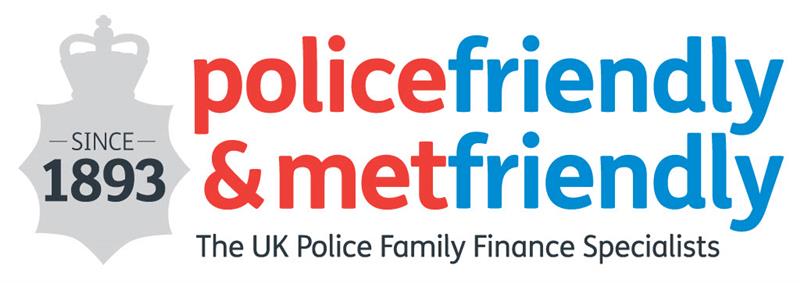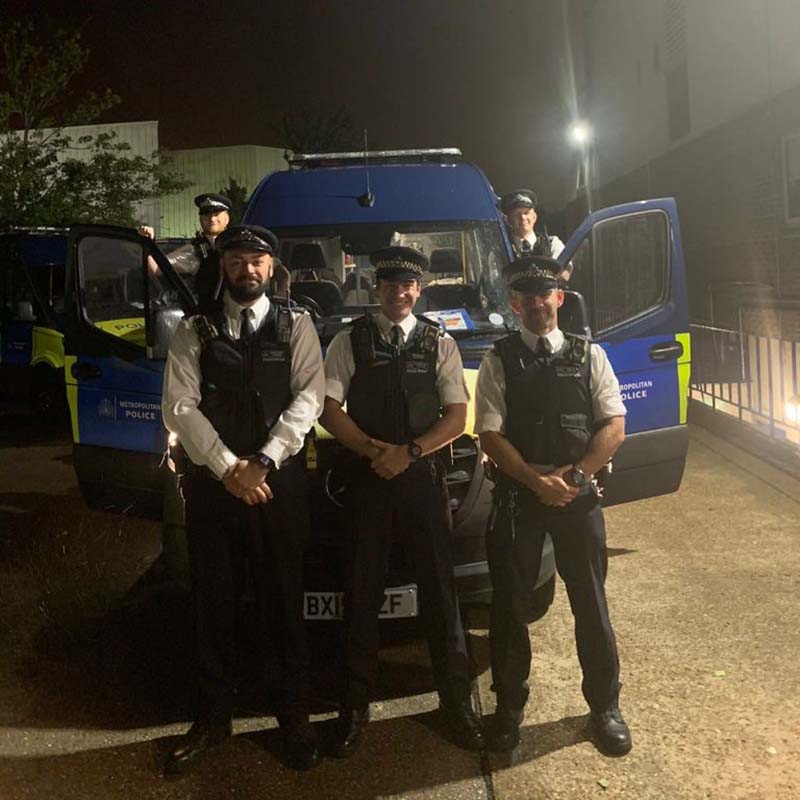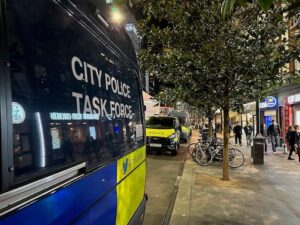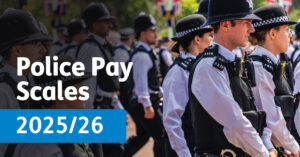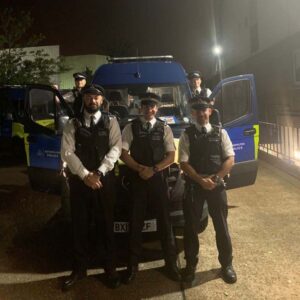When I write these blogs, I usually focus on my own life events, my family, and money rather than our members. This time is different because of an opportunity I was given recently, so please forgive my digression.
“It’s always worth going to the Awards, ceremonies and Passing Out Parades, but you’ll only really learn about what we do by seeing it for yourself”. So said Supt. Emma Richards (Task Force, Met Ops 7). A couple of weeks later, I found myself on a ride-along with TSG unit 4.2 for a night shift.
Supt. Richards was right, and while I feel like I have only scratched the surface in understanding what police staff and officers do, my respect for the Police Officers and custody staff I saw during my ride-along has gone up yet another notch. I have also added to my growing Police Service-related vocabulary.
I joined U4.2 shortly after their shift started at 2200hrs, and it wasn’t long before we were all on the bus with essential supplies (which included Percy Pigs and fizzy Colin the Caterpillars). I was with 4.2 until about 0330hrs, at which point I sank gratefully into slumber, while 4.2 carried on until their shift finished at 0700hrs.
I learned the following things:
1. The officers in TSG are very much on-the-streets, just looking out for what is going on, Police.
I’m a fan of lots of Police-based dramas, and one I used to enjoy was called The Mentalist, where someone who had previously posed as a psychic worked with the Police to use his “psychic powers” to solve various crimes. In fact, his powers were very real, but were in observing human behaviour rather than paranormal abilities.
I was amazed by the extent TSG used this, and to what great effect. The behavioural “tells” they were looking for – comfort pats, Class A scuttles, leans in or out – all seemed entirely logical and obvious when they explained them, just as they did when Patrick Jane (the lead character in The Mentalist) did his minute-56 reveal of the guilty party. The skill to be able to do this at speed and communicate it to the driver, operator and the rest of the bus was a joy to see.
The results were pretty impressive, too. I know the use of Stop and Search is controversial, but I saw 4 Stops of pedestrians (5 people), which resulted in 3 Searches (4 people). The one Stop that didn’t result in a Search was because a very quick check convinced 4.2 that there was no concern. All the rest were proven to be correctly called. That’s 80% successfully called. I forgot to ask if that was fairly normal.
2. You have to be fit to sit on a TSG bus for 8 hours.
I know that sounds a bit daft, but it is true. While I expected the officers to need to be able to get out the bus quickly and chase someone, the constant, rapid movement of the officers as they looked for and followed the tells was a real surprise to me: it was almost frenetic. Percy Pig and Colin the Caterpillar definitely play their parts in the team.
3. Clear roles and skilled people are most effective with great comms
A bus team is one Sergeant and 6 officers, one of which is a driver and one the operator. There was a constant flow of information from the officers in the bus to the operator, who simultaneously processes this with intel coming in through the headset and laptop; feeding it back to the bus; recording information and fielding inane questions from the ride-along passenger.
Using very few words – and very little time – the team communicate sights of interest and agree a course of action. The driver handles the 5m long bus like it is half its size, making the bus change direction in response to colleagues’ calls with great speed, skill, and safety.
I was also impressed with how few words the Sergeant used to direct the type of response the team would use in each situation (“two out”, “four out, two on”), evaluating what was needed to control each situation without inflaming anything.
The only time lots of words seem to be used is when talking to a member of the public – clear, unambiguous and level, even when someone resisted a search, was abusive, and subsequently assaulted one of the officers.
4. Custody suite staff are master multi-taskers
Enforcers, oil-on-water appliers, administrators, counsellors, care-takers and responders to needs of detainees and colleagues. I was only in the custody suite for about an hour, but every one of the custody team I saw in Walworth fulfilled each of those roles in the time I was there.
5. U4.2 are the best, most successful, TSG team in the Met.
I am not able to validate this, but no one in 4.2 thought PC Samantha Ryan (Sam, also 4.2) was wrong in asserting it.
I am so grateful to have had my ride-long. I plan to do more of these, and Metfriendly will use the knowledge we gain about the lives and challenges of the Police Family to shape what we do for our Members, and how we direct the money we spend on supporting them.
My thanks go to Supt. Richards for suggesting and facilitating it, Sam for arranging it, and the whole team for being so accommodating of me. Most of all though, I want to thank Callum – a quick exit specialist – for an image I won’t forget in a hurry.
Annette
Annette Petchey, CEO Metfriendly
